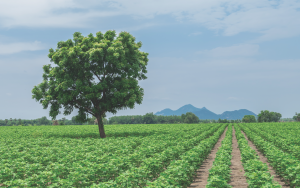
NEEM – THE HEALER
by Klaus Ferlow, HMH, HA

What makes this tree worthy to be named “Tree of the 21st Century?”
Human ingenuity has led to wondrous feats, from fire to complex social structure. Man has taken apart and put together everything he could lay his hands on – splitting atoms, reaching to the moon, mapping the human genome, connecting the World. We are living in an age of unprecedented technological strides.
The challenge before us now is to link wisdom of our past with current knowledge and technology to find ecological and sound solutions to emerging global issues such as climate change and pollution.
For thousands of years, humans have sought to fortify their health and cure various ills with herbal remedies and even today the WHO, the World Health Organization, list on their website that 80% of the world population are using herbal remedies and homeopathy for healing! The search for the true panacea, or cure-all, has been undertaken by virtually every civilization. While hundreds of substances have been tried and tested, only one has truly withstood modern science scrutiny. Perhaps no other botanical better meets the true definition of a panacea than the miraculous versatile medicinal neem tree, a tropical evergreen belonging to the mahogany family and native to India and Myanmar (formerly Burma).
Every part of this fascinating tree has been used from ancient to modern times to treat hundreds of maladies. While other herbs such as ginseng are better known, comprehensive research has proven that neem has a wider array of uses than any other plant. While it has always been revered in India, recent research has dramatically increased worldwide interest in neem, leading the new herbal products being manufactured and distributed around the Globe.
The first recorded use of neem as several thousand years ago, as ancient Indian cultures used it as an integral part of dozens of health and beauty aids. The over 5000 years old AYURVEDA botanical healing system from India is the oldest most successful medical system in the world and has utilized neem formulations.
Medical attributes of neem were extolled in the oldest Sanskrit writings. No wonder the United Nations declared the neem tree as to be “the tree of the 21st century!”
It is only in recent years that the rest of the world has shown interest in neem’s versatility and potential benefits and healing. International scientific research has explored neem’s ability to prevent and treat an astonishing number of health disorders, including those not successfully addressed by conventional pharmaceuticals!
Every part of the neem tree is used – bark, cake, fruit, flower, gum, honey, leaves, seed oil from the kernels, pulp, resin, root, timber, twigs and in India it is called “The Village Pharmacy!” The trees help prevent environmental pollution and soil erosion and rehabilitate degraded ecosystems and wasteland. Neem trees are recommended for reforestation, are useful for wind breaks in areas of low rainfall and high-speed wind, protect crops, and can be made into non-toxic pesticides, veterinarian medicine, cosmetics, and personal care products. The tree grows only in tropical and sub-tropical countries, even in the desert!
My own personal experience with neem has been nothing short of a miracle. I suffered for over 40 years with severe psoriasis on my scalp and elbows. However, when I started using neem cream, shampoo, conditioner, oil blend, soap, and tincture, I found myself free of psoriasis but needed to use it continuously. If you want to learn more about neem, please check the link: www.neemresearch.ca/shop about my book “Neem: Nature’s Healing Gift to Humanity”, published in 2015 available in paperback and as an e-book on amazon.
Of all the plants proven useful throughout the ages, few have offered as much as versatility as the neem tree. With growing research supporting its healing properties, neem is finally getting the attention it deserves.
More information about the neem tree can be obtained from checking these links:
www.neemresearch.ca, www.worldneemorganisation.org, www.neemfoundation.org, https://neem.world, https://www.ferlowbotanicals.com
Words of Wisdom
It is health that is real wealth and not pieces of gold and silver.
Mahatma Gandhi
Klaus Ferlow, Honorary Master Herbalist (HMH), Dominion Herbal College, Herbal Advocate (HA), Canadian Herbalist’s Association of B.C., innovator. Lecturer, researcher, writer, founder of Ferlow Botanicals and NEEM RESEARCH, Vancouver, B.C., Canada, member of Health Action Network Society, Ayurveda Association of Canada, Natural Health Federation, International Herb Association, United Plant Savers, core-found member of the World Neem Organisation, Mumbai, India., co-author of the book “7 Steps to Dental health:, author of the book “:Neem: Nature’s Healing Gift to Humanity”
The information in the article is summarized for its educational value and should not be used for the diagnoses, cure, treatment, or prevention of any disease. Please contact your health care provider.

Leave a Reply